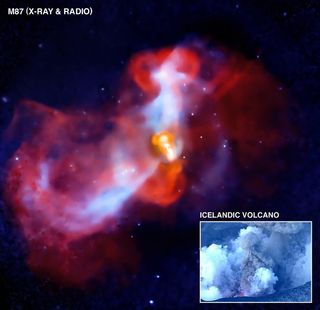Galactic 'Supervolcano' Seen Erupting With X-Rays

A galactic"supervolcano" in the massive galaxy M87 is erupting, blasting gasoutwards. The cosmic volcano ? driven by a giantblack hole in M87's center ? is preventing hundreds of millions of newstars from forming.
An image,taken by NASA's Chandra X-ray Observatory and the National Radio AstronomyObservatory's Very Large Array, captures the drama in action. [Photo of thegalactic "supervolcano."]
"Ourresults show in great detail that supermassiveblack holes have a surprisingly good control over the evolution of thegalaxies in which they live," said Norbert Werner of the SLAC NationalAccelerator Laboratory in Melo Park, Calif., who led one of two studies ofM87's black hole and its effects. "The black hole's reach extends everfarther into the entire cluster, similar to how one small volcano can affectpractically an entire hemisphere on Earth."
X-raygalaxy
M87 is about 50 million light-years from Earth and lies at the center of theVirgo cluster, which contains thousands of galaxies. M87 is filled with hot gasthat emits X-ray light, which is detectable by Chandra. As the gas cools, itcan fall toward the galaxy's center, where it should continue to cool evenfaster and form new stars.
Yet, radio observations from the Very Large Array suggest that in M87, jets ofvery energetic particles produced by the black hole interrupt this process.These jets lift up the relatively cool gas near the galaxy's center and produceshock waves in the galaxy's atmosphere from their supersonic speed.
Scientistshave found that the interaction of this cosmic "eruption" with thegalaxy's environment is very similar to volcanic processes on Earth. Inparticular, the researchers compared it to the aftermath of the Eyjafjallajokullvolcanic eruption, which forced much of Europe to close its airportsearlier this year.
Get the Space.com Newsletter
Breaking space news, the latest updates on rocket launches, skywatching events and more!
The energetic particles produced near the black hole rise through theX-ray-emitting atmosphere of the cluster, lifting up the coolest gas near thecenter of M87 in their wake, similar to the way hot volcanic gases drag upclouds of dark ash.
Galaxy'sgas plumes
In M87, the plumes of cooler gas being lifted upward contain as much mass asall of the gas contained within 12,000 light-years of the center of the galaxycluster. The black hole-powered supervolcano is thus very efficient at blastingthe galaxy free of the gas that would otherwise cool and form stars.
"This gas could have formed hundreds of millions of stars as massive asour own sun, if the black hole had not removed it from the center of thegalaxy," said Evan Million, a graduate student at Stanford University inPalo Alto, Calif., and lead author of a second paper to be published about M87.
The eruption within M87 that lifted up the cooler gas likely occurred about 150million years ago, but a smaller eruption only about 11 million years earlierproduced the shock wave, the researchers said. The Chandra image was based onan observation lasting almost 7 days.
The two papers describing these results will appear in the journal of theMonthly Notices of the Royal Astronomical Society.
- Gallery - Black Holes of the Universe
- The Strangest Things In Space
- Super-Sized Black Holes Traced to Collisions of Earliest Galaxies
Join our Space Forums to keep talking space on the latest missions, night sky and more! And if you have a news tip, correction or comment, let us know at: community@space.com.

Space.com is the premier source of space exploration, innovation and astronomy news, chronicling (and celebrating) humanity's ongoing expansion across the final frontier. Originally founded in 1999, Space.com is, and always has been, the passion of writers and editors who are space fans and also trained journalists. Our current news team consists of Editor-in-Chief Tariq Malik; Editor Hanneke Weitering, Senior Space Writer Mike Wall; Senior Writer Meghan Bartels; Senior Writer Chelsea Gohd, Senior Writer Tereza Pultarova and Staff Writer Alexander Cox, focusing on e-commerce. Senior Producer Steve Spaleta oversees our space videos, with Diana Whitcroft as our Social Media Editor.
